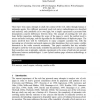Free Online Productivity Tools
i2Speak
i2Symbol
i2OCR
iTex2Img
iWeb2Print
iWeb2Shot
i2Type
iPdf2Split
iPdf2Merge
i2Bopomofo
i2Arabic
i2Style
i2Image
i2PDF
iLatex2Rtf
Sci2ools
INTR
2002
2002
Methodologies for crawler based Web surveys
There have been many attempts to study the content of the web, either through human or automatic agents. Five different previously used web survey methodologies are described and analysed, each justifiable in its own right, but a simple experiment is presented that demonstrates concrete differences between them. The concept of crawling the web also bears further inspection, including the scope of the pages to crawl, the method used to access and index each page, and the algorithm for the identification of duplicate pages. The issues involved here will be well-known to many computer scientists but, with the increasing use of crawlers and search engines in other disciplines, they now require a public discussion in the wider research community. This paper concludes that any scientific attempt to crawl the web must make available the parameters under which it is operating so that researchers can, in principle, replicate experiments or be aware of and take into account differences between ...
| Added | 22 Dec 2010 |
| Updated | 22 Dec 2010 |
| Type | Journal |
| Year | 2002 |
| Where | INTR |
| Authors | Mike Thelwall |
Comments (0)

